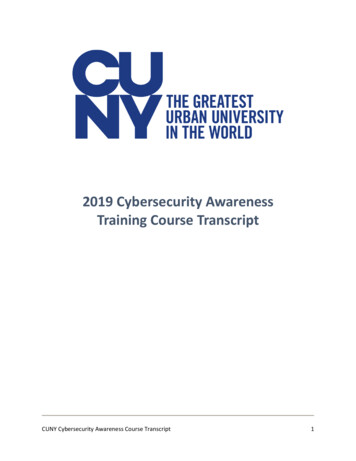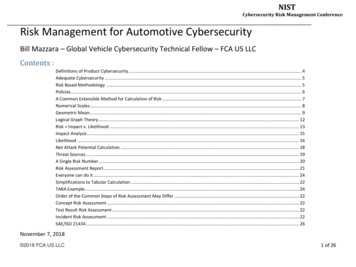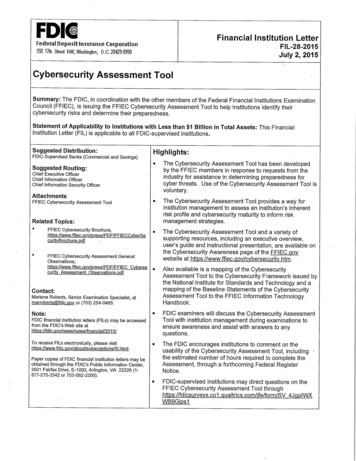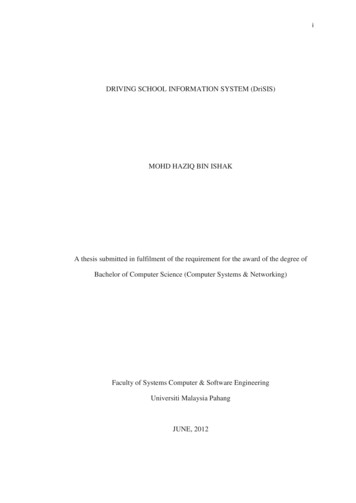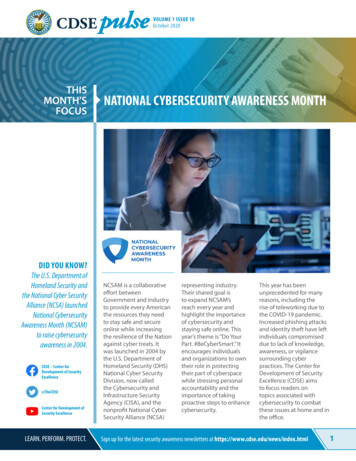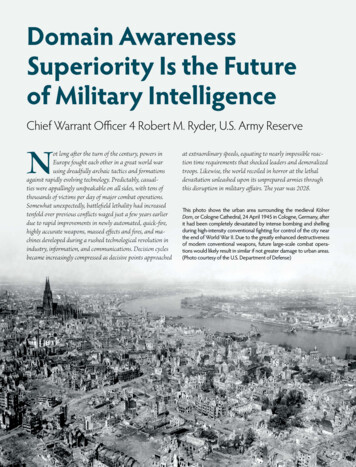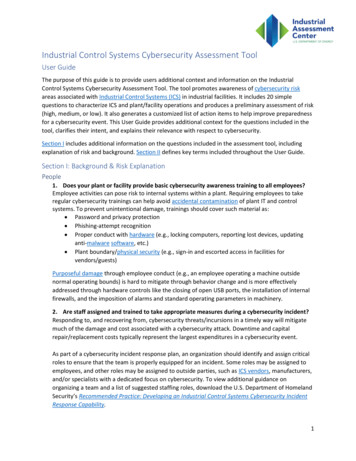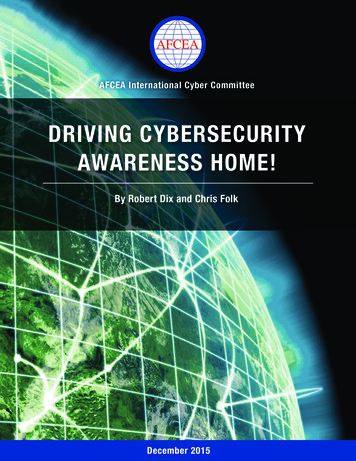
Transcription
AFCEA International Cyber CommitteeDRIVING CYBERSECURITYAWARENESS HOME!By Robert Dix and Chris FolkDecember 2015
themselves from the wide range of cyber threats. An education and awareness campaignwill not be embraced by everyone or touch all users, but the opportunity for creating greaterawareness is ripe for collaboration and leadership.EXECUTIVE SUMMARYIn the cyber environment, some realities defy dispute. First, the cybersecurity challenge ispervasive and growing with an ever-evolving range of threats. Second, no one wants to be avictim of cyber crime or a cyber attack, but many people, businesses, and organizations simplydo not know how to dissuade cyber intruders.Accordingly, cybersecurity experts are presented with a great opportunity to come togetherin a global cyber community—government, private sector, academia, non-profits, and otherorganizations—to help teach stakeholders of all levels of sophistication about low-cost orno-cost measures to better protect themselves in cyberspace.Authoritative sources have estimated that approximately 80 percent of exploitable computervulnerabilities are the direct result of poor or no cyber hygiene. Put simply, users are not takingthe basic fundamental steps to raise their cyber protection profile.This is by no means intended to ignore the 20 percent more dangerous and sophisticatedthreats, such as advanced persistent threats and destructive malware. However, acomprehensive, sustained national education and awareness campaign that seeks to improvethe “80 percent factor” can significantly improve the overall national cyber protection profile.Such a campaign accomplishes two very important objectives: First, it takes an essentialstep in raising the bar of cyber protection for everyone by invoking a culture of security andresponsibility. Knowledge is a powerful tool, and users do not have to be technology experts tolearn better cyber hygiene. Second, as AFCEA has previously documented in two white papers,1improved cyber hygiene makes bad guys’ efforts more difficult to employ; causes them to haveto revise their current tactics, techniques, and procedures; and increases the cost to pursuetheir craft. All of these serve as an enhanced deterrent to those who today have few barriers totheir criminal and illicit behavior.This paper outlines a blueprint for gathering as a nation to help citizens of all ages and technicalsophistication, small businesses, and many other cyber users to learn how to better f; berEconfinal.pdf1Imagine if every member of Congress, every member of state legislatures across the country,and every local elected official adds a link to their constituent home page that points users to asite where they could learn how to better protect themselves when using their desktop, laptop,tablet, or mobile device. Imagine a national messaging campaign leveraged by the Small BusinessAdministration, the U.S. Department of Education, the U.S. Postal Service, the IRS, and otherfederal departments and agencies in their communications with citizens and businesses daily.Imagine the powerful opportunity created by a consortium of business and trade associations likethe U.S. Chamber of Commerce,2 National Association of Manufacturers, National Retail Federation,Business Roundtable,3 and more, leveraging their conduit of communications to members providingcybersecurity tips and pointing to a website with information for all levels of users.Imagine, for a moment, the ability to reach young people with a comprehensive and sustainedprogram of education and awareness throughout our K–12 and higher education communitiesthat could include a component that also focuses on cyber ethics.Imagine the entertainment industry joining the effort with a national spokesperson to deliverpublic service announcements and messaging to help invoke a culture of security andvigilance in cyberspace.Finally, imagine the impact that American media and social media can have in helping toeducate users about where to find information about simple measures that will improve theircyber protection profile.What’s holding us back from coming together as a nation is leadership, coordination, andcollaboration to produce the necessary messaging in a comprehensive and sustained mannerto fuel a true national education and awareness campaign. Collectively, U.S. agencies havea history of success in such campaigns. For example, just a couple of years ago, they taughtfolks to cough into their sleeves and wash their hands more often to protect themselves frombeing infected by the potentially lethal H1N1 virus. Hand sanitization efforts became a regularpart of the office, retail, and home landscape. The comprehensive and sustained campaignwas effective and likely saved lives.We can no longer get by thinking, “Cybersecurity is someone else’s responsibility,” or “Asecurity breach cannot happen to me.” Changing behavior, invoking a culture of security,and at least teaching basic hygiene in the cyberspace environment are part of our collectiveresponsibility. The infrastructure already exists to make this happen. In the interest of nationaland economic security, let’s get to it.2015 Cybersecurity Campaign: Improving Today. Protecting Tomorrow. gn3More Intelligent, More Effective Cybersecurity Protection ligent-more-effectivecybersecurity-protection2
DRIVING CYBERSECURITYAWARENESS HOME! BY ROBERT DIX AND CHRIS FOLKAs much as 80 percent of the threats the Americanpublic faces today in the cyber ecosystem stemfrom poor or non-existent computer hygiene.4 Ouradversaries are using the “80 percent issue” to theirstrategic advantage and systematically degradingour national infrastructure; subverting our economicand military superiority; eroding our confidencein the government to protect and defend; and,ultimately, turning back the clock on Americanprosperity. The America we live in today allows ouradversaries to routinely violate our third amendment5rights, pilfer the very essence of our lives, and facilitate the global wholesale exchange of ourmost intimate personal details. This seems to be all done at will, at little cost, and with no concernof being caught and prosecuted. Alarmingly, this unabated threat—while unintentionally aided bythe victims—allows unprecedented access to our systems, data, and lives.The Challenges the Nation Faces Are a Whole-of-the-Nation ChallengeCybersecurity is not solely a government problem. All citizens should participate and understandtheir role. As noted in a January 2014 interview with Peter W. Singer, author of Cybersecurityand Cyberwar: What Everyone Needs to Know, “ . the biggest successful attack on the U.S.military, the one that got in their secure networks, all happened because someone picked upa memory stick that they found in a parking lot andplugged it into their computer.” Clearly there is anoutstanding need for greater awareness, education,A 2014 Obama administrationand accountability among all citizens.report found that so-calledCyber ecosystem threats today are not limited tophishing attacks—wherenation-state actors with piles of sophisticated weaponsusers are duped into clickingand trained national armies. All they need is a computerlinks that open systems toand the Internet. In addition, the attacks aren’t justhackers—are the most widelyon government systems—more and more attacks areattempted on corporations, for example, the Decemberreported cyber incident.2014 attack on Sony, the September 2014 attack onHome Depot, and the December 2013 attack on ents/CyberEconfinal.pdf.Alan Butler, When Cyberweapons End up on Private Networks: Third Amendment Implications for Cybersecurity Policy, 62 American UniversityLaw Review 5 (2013) tent.cgi?article 1886&context aulrThe number of attacks targeted at individuals also is increasing. From 2013 to 2014, social mediaspam increased 650 percent and 99 percent of malicious URLs with inappropriate content led tomalware installation or credential phishing sites.6 What these significant attacks all have in commonare that individual citizens are the target, which begs the question, what can they do to employbasic computer security practices to help them reduce their individual vulnerability and decrease theaggregate vulnerabilities?Understanding the “80 percent challenge” and the underlying premise behind it—that we canboost our defenses by routinely implementing computer hygiene—can increase our defensegame significantly. If we better educate individuals, and if we forge stronger partnershipsbetween citizens and the industry and government sectors, we can raise the cost of attacks tothe adversary.7 We can turn the 80 percent problem into the 80 percent solution.Gap in Educating the PublicGovernment agencies, private companies, and law enforcement organizations concentrate onoutreach and partnership during work hours; however, an outstanding need to communicate ina unified manner to those who may not be consciously thinking about cybersecurity outside ofwork hours exists. There must be a national, easy-to-use program for the average American toreduce the 80 percent low-end threat, thereby raising adversaries’ attack costs.Almost all Americans assume that privacy is protected and systems must be protected or areautomatically secure. This mistaken notion and its accompanying doctrine of cyber defensehave allowed this view to impede our nation’s citizenry to feel a sense of personal responsibilityand capability. The combination of these erroneous beliefs and a commonly held view thatcomputers and IT systems are too technical and mysterious abates any personal responsibilityon the part of the very users of these systems. As a result, our cyber adversaries exploit themassive unsecured nation and use it to launch sophisticated attacks. Unprotected, unwittingusers facilitate our adversaries’ ability to use these systems to serve as massive botnetplatforms that further exacerbate the attacks.As citizens use and demand more online capabilities, they enlarge their online presence andbecome more dependent upon these systems to manage day-to-day transactions safely andsecurely. Albeit convenient for users, this also permits the exchange of valuable information. Toooften, there is an assumption that the information is safe.There is an extraordinary need to better educate users so they can take personal responsibilityfor their own safety and security in this space. Currently, there is a gap, primarily because userssimply don’t understand what the cyber threats are, how their information can be compromised,or what to do. We can and must change that.4657Cybersecurity and Cyberwar: What Everyone Needs to Know, Friedman and nts/CyberEconfinal.pdf
THE IDEASignificantly Enhance Our National Campaign of Cyber Education and AwarenessLike the U.S. Stay Safe Online and the UK Get Safe Online cyber initiatives, this proposednationally led, individually empowered and integrated coordinated program addresses the 80percent cyber challenge. It raises the nefarious strike costs to our adversaries and enablesour cyber defenses to focus valuable time and resources on the remaining challenges facingour cyber defenders. A coordinated and integrated nationally led program would articulate thecybersecurity challenges that leverage existing sets of outreach and communication conduitsand mechanisms. The program would combine very easy-to-understand guidelines andemploy solutions underpinned by a set of non-product-specific protective measures and bestpractices. Further, government and private groups who already engage with their customers andconstituents would promulgate these solutions to individuals, groups, businesses—especiallysmall- and medium-size—and non-profits alike.Strategic DriversThis is essentially a discussion about a cultural change around cybersecurity. Teachingconsumers the basics of what they can do, as well as the ramifications of not employing basiccomputer hygiene, will have cascading effects throughout the IT ecosystem. The end vision isto empower individuals to protect themselves, practice the basics, AND ask for more. Theindividual can go from clicking on anything to pausing and thinking of security first. This, in turn,will foster action, and developers and businesses will bake better security measures into theirproducts. Once the shroud of mystery on “cyber” begins to lift and users have consistent andeasy-to-understand information, they will, by human nature, demand products and services thatforce “security-easy” to be a central feature of their offerings. This cultural shift has to occur,and it must begin today.Establishment of a national voice on the security of our cyber ecosystem must originate from thetop. Currently, there are a number of individual efforts by government agencies, corporations,and other organizations to educate the public about cybersecurity threats. However, with theinflux of information and spoofed sites, consumers are overwhelmed with determining whatinformation to heed because it is valid. The Office of the Cybersecurity Coordinator at theWhite House should be a focal point for a comprehensive, sustained, and coordinated nationaleducation and awareness campaign for cybersecurity.We must not lose sight that markets influence behaviors and vice versa. Empowering thevoice of the people to demand change is a powerful tool. If users, consumers, and averagecitizens are ignorant of the issues and hold onto the belief that cybersecurity is either not theirresponsibility or extremely technical, change will be elusive. Demystifying this space a bit andfostering a sense of the American can-do attitude along with easy-to-follow advice can changeconsumers into well-versed and security-conscious technology users.Integration opportunities abound with and amongthe numerous federal departments, agencies,and other entities that have an official role or atacit role in articulating and promulgating cyberdefensive messages to their constituencies,customers, or users. The never-ceasing demandand legitimate need for federal departmentsand agencies to “offer more” and to provideintegrative, ubiquitous online services to theAmerican people continues unabated. Thisextends into every aspect of our lives, whichmeans that those charged with providingservices can also provide value. Existing within those relationships are conduits that can be easilyleveraged—and at exceptionally low cost—to add value to services by exposing and enhancingsecurity as a duty and right of each citizen. Coordination with the existing capabilities in thegovernment’s daily interactions with the public, as well as the myriad other online engagementscompanies have each day with interested parties, present an already existing venue to reshapeand empower the people to regain, or at the very least improve, their own security.Coupled with and leveraging the enormous communicative capabilities that reside throughoutthe private sector, academic and nonprofit communities, the prospect of raising awarenessacross a broad spectrum of the user stakeholder community invites our enthusiasm and ourcollaboration. What an amazing opportunity to demonstrate true partnership toward a commonand national benefit!Education and broad awareness of what each of us must—and can—do to defend ourselves isa key tenant of inverting the onslaught brought upon us by adversaries that rely on our naturalreticence to do what we should do.
Together, We Can Stem the Tide and Change the DirectionA one-stop-shop where the public can go for the latest andgreatest cybersecurity news and tips as well as obtain moredetailed information is needed. Links to organizations andagency websites are just one example of a basic resource.Behind this campaign, a concentrated national outreach effort isrequired to reiterate the need for individuals to feel empowered,involved, and action-oriented as part of the cyber threat andprotection process.To address this set of challenges, a coordinated national education and awareness campaignis necessary that includes relatable language, easy-open access, coordinated messages, andconsistent and broad applicability to all entities in the cyber ecosystem. This multi-step engagementwill require dedication and passionate leadership. The first step is critical, and while some basicsteps have been taken, the value and usefulness of the current initiatives are questionable.Fundamental to any national voice is an integrated and coordinated approach to changing theunderstanding and messaging to energize citizens to accept that this is our call to arms. Famouscampaigns that demonstrate the value of a national voice include: Smokey the Bear, Rosie theRiveter, and the personification of Uncle Sam as the United States.The opportunity exists to launch a similar national campaign for cybersecurity. A symbol andslew of advertising and public service announcements encouraging everyday citizens to beactive defenders of their cyber capital to protect themselves and others is sorely needed.Stepping up to a national call to action is part and parcel to the American esprit de corp.Individual accountability is a source of pride and a sense of ownership as American as applepie. This campaign would play on all those themes and begin that cultural shift in understandingand taking action against this challenge.Cyber Awareness – Bringing It Back H-O-M-ENumerous cyber efforts and initiatives are identified and implemented by corporations, agencies,and organizations across America to keep employees safe and informed. But what about theeveryday citizen who may not be connected, including retirees, veterans, children, and stay-athome parents? How do we bring control to what looks like a cyber version of the Wild West?We take it to where the problem manifests, to where the solution rests. We take it to where ourstrength lies. In short we take it HOME!PROPOSED CAMPAIGN TOBRING IT HOME!Engagement of Leadership: They say every journey begins with a single step. In this case,the first step is a campaign to sway the administration. This paper, along with leadershipfrom AFCEA, is that first step. Communicating this idea, working to find that integrated andcoordinated national approach to cyber education, and increasing awareness to reduce the 80percent problem is an easy but incredibly powerful platform for the administration.A simultaneous step is to identify leaders in both chambers of Congress on both sides of theaisle to champion a “call to colleagues.” They must ask their colleagues to make cybersecurityresources a standard link on each of their constituent websites and to support the adoption ofthis national nonpolitical campaign.Integrating the Resources: Essential to the long-term success of this effort is theestablishment of a place where collective knowledge can be shared and citizens, businesses,and services can convene. This national cybersecurity website, perhaps named Stay SafeOnline, would be a singular unique resource that features practical advice about how to protectindividuals, computers, and mobile devices. It would include information for businesses abouthow to battle fraud, identify identity theft, stem the effects of viruses, and combat online threats.In addition, the website should contain guidance on related cyber subjects, such as basiccomputer hygiene, the elements of a strong password, the importance of backing up data, andthe ways to avoid theft or loss of systems, smartphones, and tablets. Every conceivable topicwould be included on the site, even safe online shopping, gaming, and dating, as well as how toidentify and stop cyber bullying/harassment/stalking.Fully integrating K–12 and higher education into this program would include teaching cyberethics, which would add a valuable dimension to this national effort. This one-stop-shopwould feature cyber news as well as tips and stories from around the world related to the topicto instruct the students how to protect themselves while online. The website would providetip sheets, studies, info graphics, quizzes and other resources for audiences. This variety ofvehicles would help users digest information in different ways.
The website would be structured to provide cybersecurity resources:By audience: parents (e.g., protecting your children; online monitoring of Web activity; and protecting youraging parents by making them aware of hazards such as phishing attacks) businesses both small and large (e.g., best practices in protecting your company’s securitynetworks; educating your employees) educators home users children government personnel owners and operators of critical infrastructure.By action: Instructions about computer protection, safe shopping habits, downloading apps, and the insand outs of social media will be explained. All materials on this website or communicated via other mechanisms would be in easy-tounderstand language. This would require establishment and propagation of jargon-free cyberdefense terms, ideas, and approaches. One example of the clarity needed is the Stop. Think.Connect. campaign. The site must be written and designed with simple-to-relate-to termsand approaches that average citizens can easily understand and act upon.The one-stop-shop website also would facilitate the organization of national events, such asNational Cybersecurity Awareness Month, and encourage partnerships with law enforcementagencies and other organizations to support their outreach activity, internal awareness andcustomer online safety. This would include: The White House and each state government official and member of Congress would featurelinks to the Stay Safe Online resources on their website. Each federal department and agency would include links to the Stay Safe Online and agencyspecific cyber items that are unique to their citizen services. For example, the IRS wouldhave tips about how to protect personal identifiable information and third-party vendorinformation on its section of the website.Hence, the website would serve as a mechanism for agencies to share their information, linktheir websites, showcase their broader efforts, and support cybersecurity.Establishing the Call to Arms: To attract users tothese informational websites, they must be designedin a style similar to the Smoky the Bear, The More YouKnow, or the H1N1 Awareness national campaigns.Several elements will be required to accomplish thislevel of notoriety, including: One or more national celebrities should be recruitedto raise awareness of the information-sharingeffort. Someone like Jennifer Lawrence who fits ademographic AND has been the victim of a cyberincident would lend credibility to the campaign. Potential partnerships with organizations suchas the Cyber Civil Rights Initiative, which is anadvocate for ending cyber revenge porn, wouldbring attention to the new website quickly becauseof their reach to an established audience andcredibility. Famous video gamers who may have had theirinformation stolen online would attract the attention of children and their parents then relateto them. A commercial to run during the Super Bowl should be created. Businesses should be urged to provide basic cybersecurity services and/or products free ofcharge. Could the government fund this? Widespread placement of simple information notices about basic computer hygieneapproaches similar to the H1N1 reminders would be a continuous reminder of the importanceof protecting computers and personal information. “Protect your phone/device from theft” advertisements could be posted in places such aspublic transportation stations. Partnership opportunities and distribution of information by major cellphone providers andInternet of Things device manufacturers should be encouraged.Government-Centric Initiatives: The federal government is the only place to showcase thecommitment and capacity to drive change. To that end, federal departments and agencies musttake an active role in beginning to address this 80 percent issue. As online citizen services increase, connecting to them should carry a burden of security. Dosystems that connect to the U.S. government require certain security standards? Any receipt of money from the government should require contingencies for cybersecurityfrom the recipient.
The HOME Campaign:H: Hygiene Do what you can to keep systems up-to-date. Run anti-virus programs and patches. Understand what makes a strong password. Don’t click on suspicious links. Stay up-to-date on the latest phishing schemes being reported by news media.O: OwnershipFeel empowered and take control.Protect your personal information; adversaries are always on the prowl for it.When sick, you go to a doctor. Treat your computers and mobile devices the same way. Itis up to you to take care of them. Protect them so your devices do not become unwittingaccomplices in cyber attacks by helping to spread viruses.M: MultipliersKeep in mind that as the capabilities of technologies multiply, so do the avenues for adversariesto attack. For example, over the past five years, many smartphones have become integratedinto your life—from tracking your fitness to taking videos to enabling you to communicate withcoworkers and friends abroad. The possibilities are truly endless. However, the possibilities forthe number of ways you are vulnerable to attack also are truly endless. This environment willonly continue to grow as smart technologies continue to be incorporated into our everyday lives. Remain aware that a desktop or laptop computer is not the only door into your personalinformation. Every device you own multiplies the opportunities for adversary mischief anddata theft.E: EcosystemYour individual actions are connected to and can impact the entire ecosystem. For example, ifyou don’t keep your computer patches up-to-date, you run the risk of picking up and sendingviruses to your loved ones and friends. They, in turn, can forward those viruses on, which leadsto a cascading effect of exposed personal and sometimes proprietary information. Our nation’s leadership, government, and private companies are all responsible for providingtools to keep this ecosystem strong and thriving. Consumers should be asking for, no, they should be demanding these tools.Leadership to Bring This Proposal to the Government’s AttentionAFCEA International’s Cyber Committee, in partnership with AFCEA leadership, will take therole of assembling this program and making it a specific Standing Subcommittee focus. Thissubcommittee would play the key role in implementing this effort and coordinating it amongstakeholders, including federal sponsorship from both Congress and the executive branch—such as NIST, the Department of Homeland Security, and the Small Business Administration—aswell as partners from key private sector companies and trade associations.The time and attention of the nation on thistopic need to be addressed today. Cybersecurityideas and issues must be demystified. Individualresponsibility must be clearly understood, aswell as the actions taken by each person tobegin addressing what many call the 80 percentproblem.Sophisticated government and industrycyber defenders fight day in and day out withadvanced cyber adversaries, when our citizenrydoes not participate in basic computer hygiene.This leaves the defense of our identities, our personal information, our economy, and our livesat risk to adversaries looking for the easiest way in. Users must understand their role in basiccomputer hygiene and what they individually can do. Users must ask for more secure products.The government can help facilitate and make sure there are stronger policies and higherstandards for security, but all citizens must drive these actions.This is a way that the Internet generation can fight back; this is a way they MUST engage;and, this is the way we must signal to our adversaries that we will not go quietly into the cyberecosystem night. There must be a persistent training environment where all citizens are madeaware of the threats; are actively defending their technology; and are aware of what each ofthem can do in the evolving cyber landscape they live in.Copyright 2015 AFCEA International. All rights reserved.All distribution must include www.afcea.org.
The AFCEA International Cyber Committee White Paper Serieswww.afcea.org/committees/cyber
Cybersecurity is not solely a government problem. All citizens should participate and understand their role. As noted in a January 2014 interview with Peter W. Singer, author of Cybersecurity and Cyberwar: What Everyone Needs to Know, " . the biggest successful attack on the U.S.
